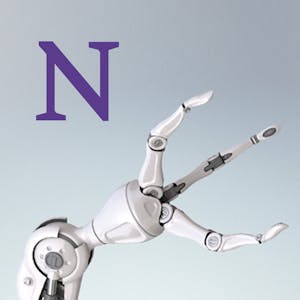Modern Robotics, Course 4: Robot Motion Planning and Control
About this Course
Do you want to know how robots work? Are you interested in robotics as a career? Are you willing to invest the effort to learn fundamental mathematical modeling techniques that are used in all subfields of robotics? If so, then the \"Modern Robotics: Mechanics, Planning, and Control\" specialization may be for you. This specialization, consisting of six short courses, is serious preparation for serious students who hope to work in the field of robotics or to undertake advanced study. It is not a sampler. In Course 4 of the specialization, Robot Motion Planning and Control, you will learn key concepts of robot motion generation: planning a motion for a robot in the presence of obstacles, and real-time feedback control to track the planned motion. Chapter 10, Motion Planning, of the \"Modern Robotics\" textbook covers foundational material like C-space obstacles, graphs and trees, and graph search, as well as classical and modern motion planning techniques, such as grid-based motion planning, randomized sampling-based planners, and virtual potential fields. Chapter 11, Robot Control, covers motion control, force control, and hybrid motion-force control. This course follows the textbook \"Modern Robotics: Mechanics, Planning, and Control\" (Lynch and Park, Cambridge University Press 2017). You can purchase the book or use the free preprint pdf. You will build on a library of robotics software in the language of your choice (among Python, Mathematica, and MATLAB) and use the free cross-platform robot simulator V-REP, which allows you to work with state-of-the-art robots in the comfort of your own home and with zero financial investment.Created by: Northwestern University

Related Online Courses
This is a self-paced lab that takes place in the Google Cloud console. Dev Ops best practices make use of multiple deployments to manage application deployment scenarios. This lab provides practice... more
As the fastest-growing sectors of the current global economy, both hospitality and healthcare services sector offer tremendous growth opportunities for incumbents and entrepreneurial opportunities... more
Course 4 focuses on using git for open source software distributed development. Git is a revision control system which arose out of the Linux kernel development community. Git was designed to help... more
This course introduces a powerful set of data science tools known as the Tidyverse. The Tidyverse has revolutionized the way in which data scientists do almost every aspect of their job. We will... more
This course introduces students to the local and global lessons in health equity research and practice, covering topics such as the effects of structural drivers and systems of power on health... more







